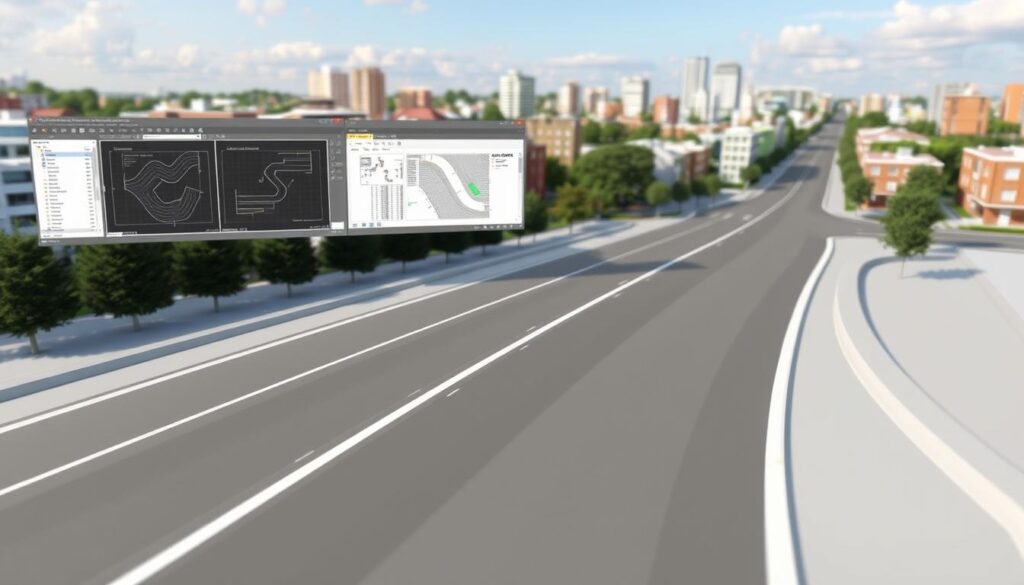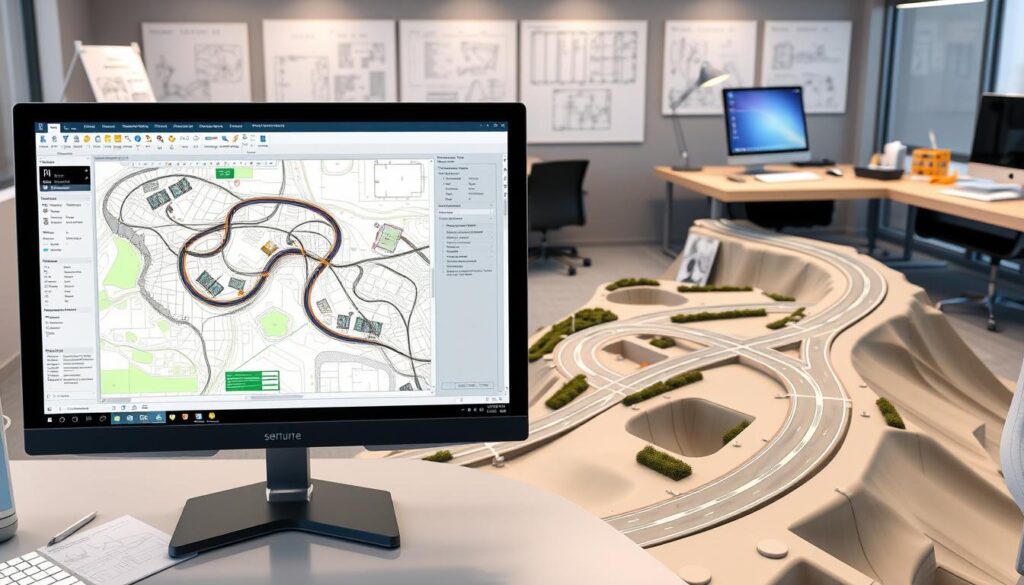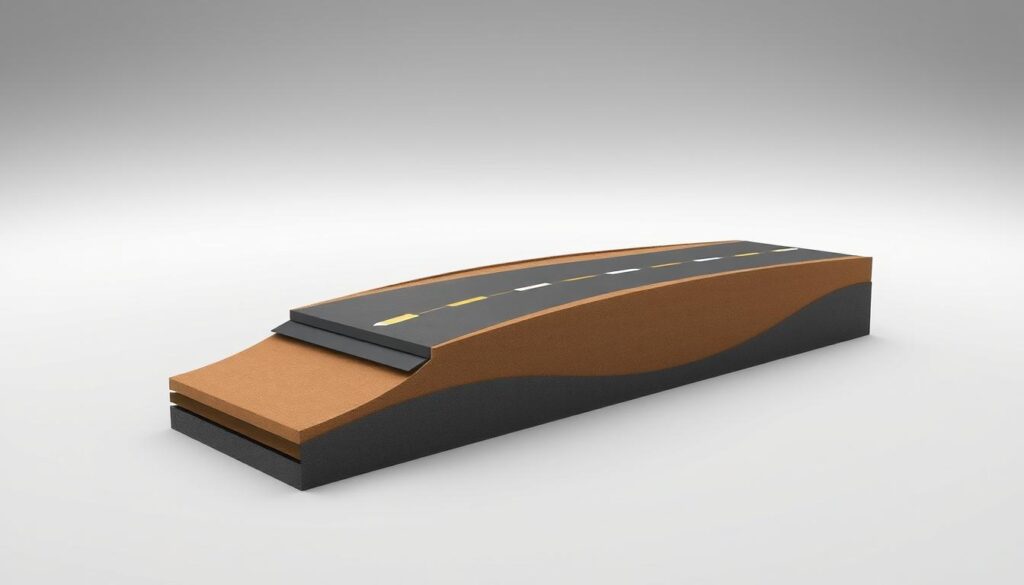The infrastructure development landscape is witnessing a significant transformation, with road design being a crucial aspect. Did you know that efficient road design can reduce traffic congestion by up to 20% and improve safety by 15%?
AutoCAD Civil3D is at the forefront of this transformation, offering a comprehensive toolset for civil engineers and designers to create precise and efficient road designs. With its advanced features, Civil3D road design capabilities enable professionals to tackle complex projects with ease.
The importance of accurate and detailed road design in AutoCAD Civil3D cannot be overstated, as it directly impacts the success of infrastructure projects.
Key Takeaways
- AutoCAD Civil3D enhances road design efficiency and accuracy.
- Civil3D road design features improve project outcomes.
- Effective road design reduces traffic congestion and improves safety.
- AutoCAD Civil3D is a vital tool for civil engineers and designers.
- Mastering Civil3D road design is crucial for successful infrastructure projects.
Understanding AutoCAD Civil3D for Road Design
AutoCAD Civil3D is a powerful tool for road design, offering a comprehensive set of features for transportation engineering projects. Its ability to handle complex design tasks makes it an ideal choice for civil engineers.
What Makes Civil3D Ideal for Road Design
Civil3D stands out due to its comprehensive design capabilities, allowing for the creation of detailed road designs that include alignments, profiles, and cross-sections. Its dynamic modeling capabilities ensure that changes made in one part of the design are automatically reflected throughout the project, saving time and reducing errors.
Key Features for Transportation Engineering
The software includes several key features tailored to transportation engineering, such as:
- Advanced alignment and profile design tools
- Corridor modeling for complex road designs
- Cross-section creation and analysis
- Integration with other Autodesk tools for a seamless workflow
System Requirements and Setup
Before diving into Civil3D, it’s essential to ensure your system meets the minimum requirements, which include a compatible operating system, sufficient RAM, and a capable graphics card. Proper setup involves configuring the software to suit your project’s specific needs, including setting up the drawing environment and customizing tool palettes.
By understanding these aspects of AutoCAD Civil3D, users can better leverage its capabilities for road design, leading to more efficient and accurate project outcomes.
Getting Started with Civil3D for Road Projects

The journey to creating precise and detailed road designs using AutoCAD Civil3D begins with setting up your project correctly. This involves several key steps that lay the foundation for your design process.
Setting Up Your Drawing Environment
To start, it’s crucial to configure your drawing environment. This includes setting the appropriate units, scales, and precision levels. AutoCAD Civil3D allows you to customize these settings to match your project’s requirements, ensuring accuracy from the outset.
Understanding the Civil3D Interface
Familiarizing yourself with the Civil3D interface is essential. The software is equipped with a range of tools and palettes that facilitate various aspects of road design, from alignment to grading. Understanding how to navigate and utilize these features effectively is key to a successful project.
Managing Project Templates
Project templates in Civil3D enable you to standardize your designs and streamline your workflow. By creating and managing templates, you can ensure consistency across your projects and reduce the time spent on repetitive tasks.
Customizing Settings for Road Design
Customization is at the heart of Civil3D’s functionality. By tailoring the settings to your specific road design needs, you can enhance your productivity and the quality of your designs. This includes configuring design criteria, assembly components, and other parameters that influence your road design.
By following these initial steps and leveraging the capabilities of AutoCAD Civil3D, you’ll be well on your way to creating sophisticated road designs. Whether you’re a seasoned professional or new to the software, AutoCAD Civil3D offers the tools and flexibility needed to bring your projects to life.
Data Collection and Site Analysis
Data collection and site analysis are crucial initial steps in creating precise road designs with AutoCAD Civil3D. These processes lay the foundation for a successful road design project by providing the necessary data to make informed decisions.
Importing Survey Data
The first step in data collection is importing survey data into AutoCAD Civil3D. This can be done by using the Import Survey Data tool, which allows users to bring in survey points, figures, and other relevant data. Accurate survey data is essential for creating a realistic model of the existing terrain.
Creating Surface Models
Once the survey data is imported, the next step is to create a surface model. This involves using the survey points to generate a 3D surface that represents the existing ground conditions. AutoCAD Civil3D provides various tools for creating and editing surface models, ensuring that the design is based on accurate topography.
Site Analysis Techniques
Site analysis in AutoCAD Civil3D involves analyzing the surface model to understand the site’s characteristics, such as slopes, drainage patterns, and other environmental factors. This analysis is critical for designing roads that are not only functional but also environmentally friendly.
Working with GIS Data
In addition to survey data, AutoCAD Civil3D also allows users to work with GIS (Geographic Information System) data. This can include importing GIS data to understand broader environmental and geographical contexts, enhancing the road design process. By integrating GIS data, designers can make more informed decisions about the road’s alignment and other design elements.
By following these steps and leveraging the capabilities of AutoCAD Civil3D, engineers and designers can ensure that their road design projects are based on thorough data collection and site analysis, ultimately leading to more efficient and effective civil3d road design workflow.
How to Use AutoCAD Civil3D for Road Design: The Workflow

AutoCAD Civil3D streamlines the road design process through its comprehensive workflow tools. This section will delve into the specifics of the road design workflow in Civil3D, covering key aspects such as establishing design criteria, understanding design standards, and project phasing strategies.
Overview of the Road Design Process
The road design process in Civil3D is a multi-faceted workflow that involves several critical steps. It begins with data collection and site analysis, followed by establishing design criteria that meet project requirements and regulatory standards.
Key components of the road design process include:
- Data collection and site analysis
- Establishing design criteria
- Designing horizontal and vertical alignments
- Corridor modeling
- Cross-section design and analysis
Establishing Design Criteria
Establishing design criteria is a crucial step in the road design process. It involves setting parameters such as design speed, alignment constraints, and profile grades. Civil3D allows users to define these criteria based on project-specific requirements and regulatory standards.
Design criteria may include:
- Design speed and alignment constraints
- Profile grade and elevation controls
- Cross-slope and superelevation requirements
Design Standards and Specifications
Civil3D supports various design standards and specifications, enabling users to adhere to local and international regulations. Users can configure design standards within the software to ensure compliance with project requirements.
Some of the supported design standards include:
- AASHTO standards
- Local transportation department guidelines
- International design standards
Project Phasing Strategies
Project phasing is an essential aspect of road design, particularly for large-scale projects. Civil3D allows users to develop phasing strategies that align with project timelines and budgets.
By understanding and implementing the correct workflow in AutoCAD Civil3D, engineers and designers can create efficient and compliant road designs. The software’s comprehensive tools and features support a streamlined design process, from initial data collection to final plan production.
Creating Horizontal Alignments
AutoCAD Civil3D simplifies the process of creating horizontal alignments for road design projects. Horizontal alignments are a critical component of road design, defining the road’s centerline and determining its layout. In Civil3D, creating these alignments involves several key steps and tools.
Alignment Layout Tools
Civil3D offers a range of alignment layout tools that enable users to create complex alignments with ease. These tools allow for the creation of alignments based on various design criteria, including tangents, curves, and spirals. By utilizing these tools, designers can ensure that their road designs meet the required standards and regulations.
Defining Curves and Tangents
Defining curves and tangents is a crucial aspect of creating horizontal alignments. Civil3D provides flexible options for designing these elements, allowing users to specify parameters such as curve radius, tangent length, and transition curves. This flexibility enables designers to optimize their road designs for safety, efficiency, and aesthetics.
Alignment Editing Techniques
Once an initial alignment is created, Civil3D offers various editing techniques to refine and adjust the design. These techniques include graphical editing, where users can directly manipulate the alignment geometry, and tabular editing, which allows for precise control over alignment parameters. By leveraging these editing capabilities, designers can iteratively improve their designs.
Design Checks and Validation
After creating and editing a horizontal alignment, it’s essential to perform design checks and validation to ensure compliance with design standards. Civil3D includes tools for analyzing alignments against predefined criteria, helping designers identify and address potential issues. This process ensures that the final design is both functional and compliant with relevant regulations.
By mastering the creation of horizontal alignments in AutoCAD Civil3D, designers can significantly enhance the quality and efficiency of their road design projects. The software’s comprehensive set of tools and features supports the development of precise, compliant, and optimized road designs.
Designing Vertical Profiles

Designing vertical profiles is a crucial step in road design using AutoCAD Civil3D, as it directly impacts the safety and efficiency of the road. The vertical profile, or the elevation of the road, must be carefully planned to ensure proper drainage, driver comfort, and compliance with design standards.
Profile Creation Methods
AutoCAD Civil3D offers several methods for creating profiles, including the use of surface data, existing alignments, and profile views. Users can create profiles by drawing them manually or by using the software’s automated tools to generate profiles based on existing surface models or other data.
Profiles can be created from various data sources, including survey data, digital elevation models (DEMs), or other Civil3D surfaces. This flexibility allows engineers to work with the data they have available, making the design process more efficient.
Working with Profile Views
Profile views are essential for visualizing and editing the vertical profile of a road. Civil3D allows users to create multiple profile views for different aspects of the design, such as existing ground profiles, proposed profiles, and comparison profiles.
Users can customize profile views to display various types of information, such as elevations, grades, and curve data. This capability helps in analyzing the design and making necessary adjustments to meet project requirements.
Vertical Curve Design
Vertical curves are critical components of road design, as they provide a smooth transition between different grades. Civil3D includes tools for designing vertical curves that meet specific design criteria, such as crest and sag curves.
The software allows users to define the parameters of vertical curves, including the curve length, radius, and other relevant factors. By using these tools, engineers can ensure that their designs comply with relevant design standards and specifications.
Grade and Elevation Management
Managing grade and elevation is a key aspect of vertical profile design. Civil3D provides tools for analyzing and adjusting the grade and elevation of the road to ensure that it meets design requirements and site conditions.
Users can use the software to check for compliance with design standards, such as maximum grades and minimum curve lengths. By carefully managing grade and elevation, engineers can create road designs that are both safe and functional.
Corridor Modeling Fundamentals
Understanding corridor modeling fundamentals is essential for effective road design in AutoCAD Civil3D. Corridor modeling is a complex process that involves creating a 3D representation of a road or other linear feature.
Understanding Assemblies and Subassemblies
In Civil3D, an assembly is a collection of subassemblies that define the cross-sectional geometry of a corridor. Subassemblies are the building blocks of assemblies, representing elements like lanes, shoulders, and ditches. Understanding how to configure and manage these subassemblies is crucial for creating accurate corridor models.
Creating Road Assemblies
To create a road assembly, you need to select and configure the appropriate subassemblies. This involves specifying parameters such as lane widths, shoulder slopes, and ditch geometries. Civil3D provides a range of tools and subassembly types to accommodate various road design requirements.
Building Corridors
Once you have created an assembly, you can use it to build a corridor. This involves aligning the assembly with the horizontal and vertical alignments of your road design. The corridor model will then be generated based on the assembly and alignment data.
Corridor Regions and Targets
Corridor regions allow you to control different sections of your corridor model independently. You can define targets to control specific aspects of the corridor, such as the slope or elevation of certain subassemblies. Effective use of regions and targets is key to creating complex corridor designs.
By mastering the fundamentals of corridor modeling, including assemblies, subassemblies, and corridor regions, you can create detailed and accurate 3D models of your road designs in AutoCAD Civil3D.
Advanced Corridor Design Techniques

Advanced corridor design in Civil3D involves a deep understanding of various techniques, including superelevation and intersection design. These advanced techniques enable engineers to create complex road designs that are both efficient and safe.
Working with Superelevation
Superelevation is a critical aspect of road design, particularly for highways and high-speed roads. It involves tilting the road surface to counteract the centrifugal force when navigating curves. In Civil3D, superelevation can be applied using the Superelevation tool, which allows for precise control over the banking of roads.
- Define superelevation rates based on design criteria.
- Apply superelevation to alignments and corridors.
- Analyze the impact of superelevation on road safety and performance.
Designing Intersections
Intersections are complex elements of road design that require careful planning. Civil3D provides tools for designing intersections that are both functional and safe. The Intersection tool allows engineers to create detailed intersection designs, including the layout of lanes, curb returns, and other critical elements.
- Create intersection layouts that meet design standards.
- Customize intersection components, such as lane configurations and traffic signals.
- Analyze intersection performance and safety.
Managing Corridor Surfaces
Corridor surfaces are essential for understanding the 3D geometry of a road design. Civil3D enables the creation of detailed corridor surfaces that can be used for analysis and visualization. By managing corridor surfaces effectively, engineers can ensure that their designs are feasible and meet project requirements.
Key considerations include:
- Creating accurate surface models.
- Analyzing surface data for design validation.
- Using surface information for earthwork calculations.
Corridor Troubleshooting
Despite the advanced capabilities of Civil3D, corridor design can sometimes present challenges. Common issues include misaligned assemblies, incorrect target alignments, and surface anomalies. Effective troubleshooting involves a systematic approach to identifying and resolving these issues.
Tips for troubleshooting corridors:
- Check assembly configurations and subassembly settings.
- Verify target alignments and profiles.
- Use Civil3D’s diagnostic tools to identify and fix errors.
Cross-Section Design and Analysis
The process of cross-section design and analysis in AutoCAD Civil3D is fundamental to successful road design projects. Cross-sections provide critical information about the terrain and the proposed design, enabling engineers to make informed decisions.
Creating Sample Lines
Sample lines are essential for generating cross-sections in Civil3D. To create sample lines, navigate to the “Home” tab, select “Sample Line,” and then define the alignment and the range of stations you want to analyze. Sample lines serve as the basis for extracting cross-sectional data.
Generating and Customizing Sections
Once sample lines are created, you can generate sections by using the “Section Editor.” This tool allows you to customize the display of your cross-sections, including the layers, labels, and other visual elements. Customization is key to effectively communicating design intent.
Section Analysis and Editing
After generating sections, Civil3D enables you to perform detailed analysis and editing. You can analyze the geometry, identify potential issues, and make necessary adjustments. This iterative process ensures that your design meets the required standards and specifications.
Quantity Takeoffs from Sections
One of the powerful features of Civil3D is its ability to perform quantity takeoffs directly from the cross-sections. This capability allows engineers to estimate material quantities, such as cut and fill volumes, which are crucial for project budgeting and planning.
| Task | Civil3D Tool | Benefit |
|---|---|---|
| Creating Sample Lines | Sample Line Tool | Defines the basis for cross-sectional data extraction |
| Generating Sections | Section Editor | Allows customization of cross-section display |
| Section Analysis | Section Analysis Tools | Enables detailed geometry analysis and editing |
| Quantity Takeoffs | Quantity Takeoff Tools | Facilitates estimation of material quantities |
By leveraging these features in AutoCAD Civil3D, engineers can streamline their workflow, improve design accuracy, and enhance collaboration across project teams. The result is more efficient and cost-effective road design projects.
Grading and Earthwork Calculations

Civil3D’s robust tools for grading and earthwork calculations streamline road design workflows. Grading and earthwork are critical components of road design, involving the manipulation of terrain to achieve the desired road geometry. AutoCAD Civil3D provides comprehensive tools for these tasks, enabling engineers to design and analyze grading operations efficiently.
Feature Line Grading
Feature line grading is a fundamental aspect of road design in Civil3D. It involves creating and editing feature lines to define the grading limits and boundaries. Feature lines are used to control the grading operations, allowing for precise design and modification of the terrain.
Cut and Fill Calculations
Accurate cut and fill calculations are essential for earthwork operations. Civil3D enables users to calculate the volumes of cut and fill materials, helping to balance the earthwork and minimize waste. The software provides various methods for calculating cut and fill, including composite volumes and grid-based calculations.
Mass Haul Analysis
Mass haul analysis is a critical step in road design, involving the optimization of earthwork distribution along the project corridor. Civil3D’s mass haul analysis tools help engineers to identify the most efficient distribution of cut and fill materials, reducing haul distances and costs.
Optimizing Earthwork Balance
Achieving an optimal earthwork balance is key to minimizing project costs. Civil3D allows users to adjust the grading design to balance cut and fill quantities, thereby reducing the need for external fill material or waste disposal.
Drainage Design for Roadways
Proper drainage is essential for the longevity of roadways, and AutoCAD Civil3D’s drainage design tools help engineers achieve this goal. Effective drainage design prevents water accumulation, reducing the risk of road damage and ensuring safety for users.
Catchment Analysis
Catchment analysis is a critical step in drainage design, involving the identification of areas where water collects and flows. In Civil3D, this process can be efficiently managed by creating surface models that help in understanding the topography and delineating catchment areas.
Catchment analysis steps in Civil3D:
- Create a surface model
- Delineate catchment areas
- Analyze flow paths
Pipe Network Design
Pipe network design is another vital aspect of drainage design. AutoCAD Civil3D allows for the creation of complex pipe networks, enabling engineers to design and analyze the flow of water through these systems.
Key features of pipe network design in Civil3D include:
- Dynamic pipe and structure interaction
- Automated pipe sizing
- Flow and pressure analysis
Culvert Placement and Sizing
Culverts are structures that allow water to flow under roadways. Proper placement and sizing are crucial to ensure effective drainage and prevent erosion. Civil3D provides tools to design and analyze culverts, taking into account various hydraulic factors.
| Culvert Type | Application | Design Considerations |
|---|---|---|
| Box Culvert | High flow rates, urban areas | Size, material, inlet/outlet design |
| Pipe Culvert | Rural areas, smaller flows | Diameter, slope, material |
| Arch Culvert | Aesthetic considerations, large flows | Span, rise, hydraulic analysis |
Hydraulic Analysis Integration
Hydraulic analysis is integral to drainage design, ensuring that the designed systems can handle the expected water flow. Civil3D integrates hydraulic analysis tools, allowing engineers to simulate different scenarios and optimize their designs.
Benefits of hydraulic analysis in Civil3D:
- Accurate flow simulations
- Optimization of drainage systems
- Reduced risk of flooding and erosion
Plan Production and Documentation

AutoCAD Civil3D streamlines the process of creating detailed plans and documentation for road design projects. This capability is essential for ensuring that designs are accurately communicated and implemented.
Creating Plan and Profile Sheets
Plan and profile sheets are fundamental components of road design documentation. In Civil3D, you can create these sheets by leveraging the software’s dynamic block and sheet set features. To start, you need to define your drawing template and configure the Civil3D workspace to match your project requirements.
Steps to Create Plan and Profile Sheets:
- Set up your drawing template with the necessary borders, title blocks, and other required elements.
- Use the Civil3D alignment and profile tools to create the necessary design elements.
- Employ the sheet set manager to organize and publish your sheets.
Cross-Section Sheets
Cross-section sheets provide critical information about the road’s geometry at various points. Civil3D allows you to generate these sheets using sample lines and section views.
Key Steps for Cross-Section Sheets:
- Create sample lines along the alignment.
- Generate sections using the sample lines.
- Customize section views to include necessary details.
Quantity Reports and Tables
Quantity reports and tables are vital for project estimation and management. Civil3D enables you to extract quantities directly from your design models.
| Report Type | Description |
|---|---|
| Earthwork Volumes | Calculates cut and fill volumes. |
| Pavement Quantities | Provides quantities of pavement materials. |
Annotation and Labeling
Annotation and labeling are crucial for clear communication of design intent. Civil3D offers a range of tools for annotating your designs, including labels for alignments, profiles, and sections.
Best Practices for Annotation:
- Use consistent labeling styles throughout the project.
- Leverage Civil3D’s label sets to streamline the annotation process.
- Customize label styles to match project requirements.
Collaboration and Data Sharing
Collaboration and data sharing are essential components of successful road design projects in Civil3D. AutoCAD Civil3D is designed to facilitate collaboration among project teams, ensuring that all stakeholders are on the same page throughout the project lifecycle.
Working with Project Teams
AutoCAD Civil3D allows multiple users to work on the same project simultaneously. This is achieved through data references and shortcuts, which enable team members to access and update specific parts of the project without affecting the entire dataset.
Data References and Shortcuts
Data references in Civil3D enable users to link external data to their project, while shortcuts allow for the creation of proxy objects that reference the original data. This functionality streamlines collaboration by reducing file sizes and improving data management.
Integration with Other Software
AutoCAD Civil3D integrates seamlessly with other Autodesk software, such as Revit for BIM coordination. This integration enables a smooth transition from design to construction, enhancing the overall project workflow.
BIM Coordination for Road Projects
BIM coordination is critical in modern road design projects. Civil3D’s compatibility with BIM processes ensures that road projects are executed with precision, from initial design through to construction and maintenance.
| Collaboration Feature | Description | Benefit |
|---|---|---|
| Data References | Link external data to the project | Improved data management |
| Shortcuts | Create proxy objects referencing original data | Reduced file sizes |
| BIM Coordination | Integration with Revit for BIM processes | Enhanced project precision |
Conclusion
AutoCAD Civil3D is a powerful tool for road design, offering a comprehensive set of features to streamline the design process. This article has provided a summary of AutoCAD Civil3D road design capabilities, from data collection and site analysis to corridor modeling and plan production.
By following the steps outlined in this article, you can effectively use Civil3D to create accurate and detailed road designs. The key to successful road design is to understand the software’s capabilities and apply best practices to your workflow.
For a civil3d road design conclusion, it’s essential to review your design carefully, ensuring that it meets all relevant standards and specifications. Final tips for AutoCAD Civil3D road design include staying up-to-date with the latest software features and leveraging online resources to improve your skills.
With practice and experience, you can master AutoCAD Civil3D and deliver high-quality road designs that meet the needs of your clients and stakeholders.
